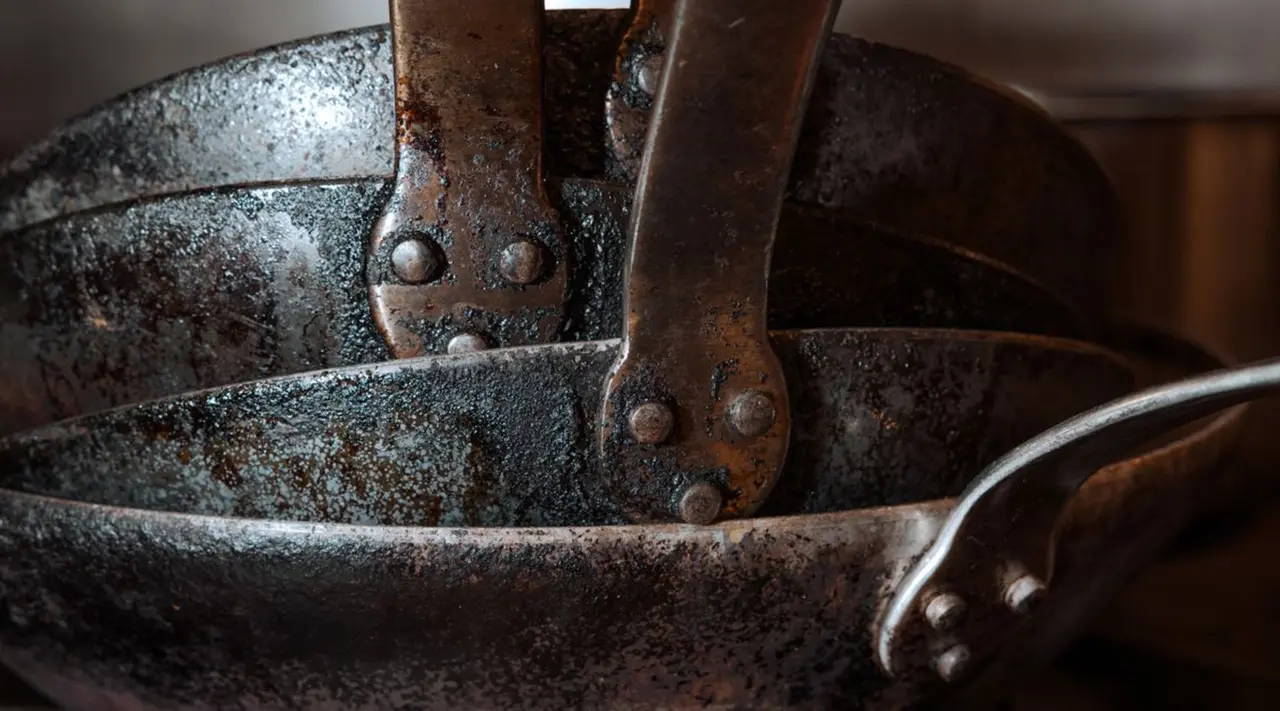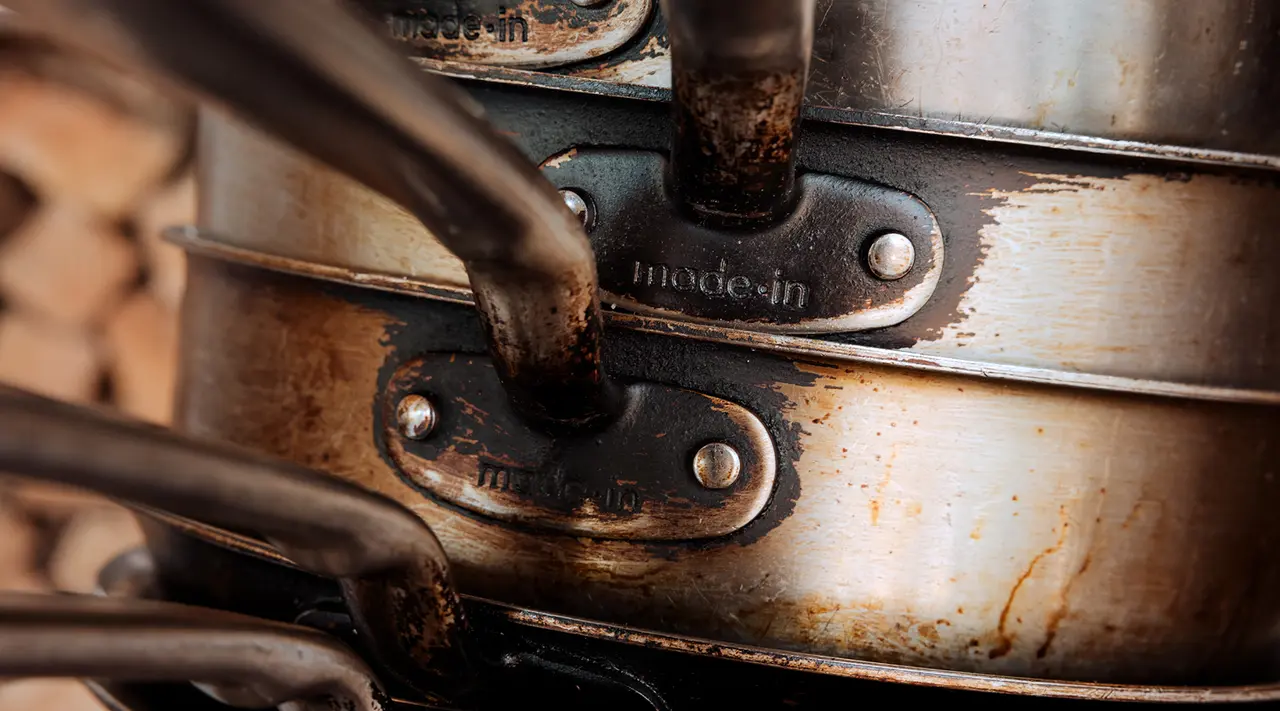In a cookware world of big promises, you may be wondering which types of pans are the best to buy. You don’t want to buy a new piece of kitchen equipment only to have it break immediately after using, and if something seems too good to be true—especially if the price is super cheap—that’s because it is. When buying cookware you want to reach for year after year, we suggest looking for materials that are long-lasting, gimmick-free, and made for function over fashion.
Let’s dive into four of the most durable types of cookware, so the days of replacing pans every year are behind you (for good).
Carbon Steel
Carbon steel takes the best qualities of cast iron and stainless steel and pairs them together to make incredibly durable cookware. Like cast iron, carbon steel is made from carbon and iron (ours is 99% iron, 1% carbon), but the final result is much lighter than cast iron. Similar to cast iron, carbon steel needs to be seasoned before using—though you can buy preseasoned skillets—in order to achieve its naturally non stick cooking surface that gets better and more non stick the more you cook with it.
Another advantage: carbon steel cookware thrives in high-heat (up to 1200F) cooking, whether it be on a stove, oven, or over a direct flame. Unlike cast iron, carbon steel responds to changes in heat quickly. For example, you can start out searing a protein and then drop the temperature to finish cooking the inside without worrying about overcooking.
Carbon Steel Care
To keep your carbon steel cookware in its best shape, you should cook with it regularly. The more you cook with it, the better it becomes—as its signature patina will build up, enabling you to cook even delicate foods like eggs and fish without sticking. Note that due to the reactive nature of carbon steel, certain ingredients should be avoided—the acid in ingredients like tomatoes, vinegar, and citrus can damage the coating. Your pan won’t be damaged, but you might need to reseason.
Always hand wash carbon steel, preferably with only warm water. For tougher cleaning jobs, check out our guide to cleaning carbon steel. In the event of rust, it’s best to deal with it right away to avoid lasting damage. We recommend scrubbing with salt, steel wool, or vinegar in our guide to removing rust.
After your carbon steel cookware is clean, dry it thoroughly, and buff in a small amount of oil to keep the seasoning in top shape, especially if you don’t know the next time you’ll reach for it. Store in a dry place, and if stacking other pots or pans on top, place a towel or non scratching trivet—like a Pan Protector—in between.
Copper
One of the oldest metals around, copper lends an instant rustic charm to your kitchen. It’s also quite durable and an excellent conductor of heat and electricity. Our copper collection comes with the added benefit of stainless cladding, ensuring it lasts longer than its predecessors (i.e., no need for retinning). This stainless steel interior can tolerate high heat (up to 800F) and makes our copper collection non reactive, so you can cook acidic foods without worry.
While some copper cookware features a tin lining, and periodically needs to be retinned, the stainless lining in our copper collection does not require reapplication. Since ours is lined with stainless steel, you can cook basically anything you would in a stainless steel pot or pan—just not on induction cooktops, as copper is not an induction-compatible cookware material.
Copper Care
When cleaning copper cookware, use a non-abrasive sponge with warm, soapy water on the outside, then dry thoroughly before storing.
With enough use, the outside of copper cookware will often develop a green-blue patina (similar to an aged penny), but the cookware itself isn’t damaged. That natural patina can be a cherished memory of all your nights cooking and entertaining, but if it bothers you, you can easily buff it off).
To make sure your copper cookware lasts for generations, be sure to wash and dry thoroughly after every use, and store it like we recommend storing all of our cookware: in a dry place, with a towel or trivet in between if stacked.
Enameled Cast Iron
Forged in France, each piece in our Enameled Cast Iron Collection features thickly poured, high-performance cast iron with a hand-applied layer of enamel coating. This easy-to-clean enamel adds a protective layer, enabling you to cook acidic ingredients in it and also rendering the cooking surface naturally non stick. Like its unfinished counterpart, enameled cast iron is known for its unparalleled durability that can last for generations.
Enameled Cast Iron Care
You should avoid heating an empty piece of cast iron cookware, as this can lead to scorching, burning, or even damaging the exterior glaze. Instead, always heat the pan with water or fat. The enamel coating is durable, but it’s not indestructible, so non abrasive utensils are recommended.
When it’s time to clean, always wash by hand with warm, soapy water and a sponge or dishcloth. In the event of a scorched pan or burnt enamel, head to our guide on cleaning enameled cast iron. Once clean, dry thoroughly before storing.
Stainless Steel
Stainless steel pots and pans are the top choice for professionals and home cooks alike, thanks to their lightweight, sturdy, and versatile nature. Crafted in Italy, our premium 5-ply stainless steel cookware features an aluminum core insulated by stainless steel.
The 5-ply construction equates to fewer hotspots while also contributing to a durable piece of cookware. Stainless steel is also quite strong, virtually rust-proof, and low-maintenance. Once you have a stainless steel pot or pan, you’ll have it for generations.
Stainless Steel Care
Common mistakes when cooking with stainless steel include washing it in the dishwasher (don’t!—even if the label says dishwasher safe), not giving the pan time to cool down after cooking (quick temperature changes can lead to thermal shock), adding salt at the wrong time (which can lead to pitting), and cleaning with abrasive products (don’t use bleach).
That said, you can keep your stainless steel in good shape by cleaning it after every use and tackling tougher jobs as soon as they happen. We’ve got a guide to help you there.
How to Choose Durable Cookware

Which type of cookware you choose depends on your personal cooking style, the types of foods you cook with most often, and how much room you have to store them. Budget is another consideration.
Key Considerations of Durable Cookware
Infomercials are fun to watch, but their products don’t usually live up to the hype. Instead, look for brands that have a good reputation and with reviews that are written by real people. Ask your friends what styles of cookware they like and if you can take their cookware for a spin. Choose from brands with a good reputation, and keep an eye out for companies that offer warranties in case of defect or wear and tear.
Features to Look For
You can often tell if a piece of cookware is durable based on the weight, material, construction, and cooking surface. Super light and flimsy cookware is just that: flimsy. Material, as detailed above, is the biggest consideration. The cooking surface, like material, also impacts longevity. Carbon steel, enameled cast iron, and stainless steel are all long-lasting, while coated options like non stick or ceramic have much shorter lifespans.
Also consider how the handle is applied to a pot or pan; most of our cookware uses rivets to attach the handles, ensuring they last, but you might see other brands with welded or screwed handles.
Budget vs. Durability
When it comes to your budget, it’s usually better to save up a little if it means you can get a better product. Not only is it the more environmentally friendly option, but choosing a piece of cookware that lasts for years instead of one that you’ll have to replace more often will ultimately mean you’re spending less money.
Ready to Shop?
When choosing cookware that will last for years, you have several options. Keep in mind your kitchen space, cooking style, and the types of foods you cook. Once you’ve settled on the type of material, you’re ready to browse through our collection of durable, made-to-last cookware.



























